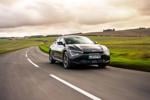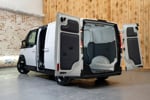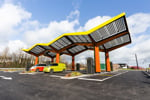Review
In a bid to build on the car's successful launch, a heavily face-lifted version of the Neon - the result of a £500million investment by the manufacturer - will come to the UK next month with its first showing to the public at the London Motor Show. Chrysler believes the new Neon will hold the key to expanding its sales from the current customer base to the rest of a largely untapped market.
While the Neon is a car for the young in its home country - where many of the 1.5 million cars sold have been bought - the UK buyer could not be more different, with an average age among the predominantly male buyers of 53. According to Chrysler, a third of buyers are at senior manager level or above, a figure which it believes shows a strong potential among the fleet market.
The face-lift attempts to build on that potential, adopting a more purposeful, sober front-end, which still has the potential to grab attention in the company car park. However, the new range is being reduced in number, despite the fleet market being the most demanding in terms of choice in Britain. The 1.8-litre engine goes - it accounted for about 17% of sales in the previous two-engine range - and neither the 1.6-litre nor diesel option will be part of the range.
That leaves a revised version of the current 2.0-litre engine, available in the outgoing range and the biggest seller. It offers the same 131bhp but has a wider torque curve for more useable power, and will be the only option in two trim levels, SE and LX. Chrysler expects to continue to hit the current 3,000 a year mark for sales of the new model.
With all its attention focused on two models, the importer is certain it will win new buyers. Price will be a key factor, with the base 2.0-litre costing £10,995 and the LX £13,495 - less than the £13,550 launch price when the Neon first came to the UK three years ago. The LX is expected to take 60% of sales.
Marketing director Steve Gray said: 'Neon customers can have a 2.0-litre engine for the price of a 1.6 which is better specified than its competitors.' For example, a Ford Focus 2.0 Ghia costs £15,320 and a Renault Megane Classic 1.6 RXE £14,220.
Specification follows in the footsteps of its predecessor, with standard air conditioning and twin front airbags as well as a three-speed automatic gearbox available on all models as a no-cost option. All versions get heated fold-away mirrors, power steering, remote central locking with a new remote boot release feature - there is also a switch in the glovebox - tilt adjustable steering and power front windows. The LX adds alloy wheels, traction control, full leather, height adjustable driver's seat and standard cruise control on the automatic to the package, making for an attractive low-cost luxury model for fleet drivers.
There is also more interior space, despite the body being just one mm wider. Thanks to a wider track, there is nearly an inch more shoulder room in the front and one and a half inches in the back. Legroom is uprated by 24mm in the front and 12mm in the rear thanks to some nifty design work, a longer wheelbase and the car being 26mm longer overall than the 'old' Neon. Boot space in the saloon-only range is increased from 11.8 to 13.1 cubic feet, but there's a high sill.
On the road, the investment in European test driving to create a new suspension set-up for Neons destined for our shores, combined with a stiffer body for better cornering characteristics, has paid dividends. During a test drive in the vast countryside surrounding Chicago for the European launch, the left-hand-drive Neon proved it could hold its own on tight bends and put in a good turn of speed, although the 2.0-litre 16-valve engine did not relish high revs, which were needed to match the claimed 0-60mph time of about 9.5 seconds.
However, the leather seats and air conditioning helped to combat fatigue during a 300-mile drive and noise was not too intrusive. Gear changes were light in the manual, but not as smooth nor as precise as a Ford Focus or Vauxhall Astra, its two key rivals. The three-speed automatic - which currently takes 70% of UK sales - was not available to test, but it is unchanged from the current model. Although four-speed autos are now pretty much standard, Chrysler believes the current unit can still hold its own.
Visibility was obscured by the driver's rear-view mirror to the front and a high sill at the rear, which meant that reversing was predominantly guess work. Build quality was good and switchgear was solid, although their placings were a bit haphazard, such as the remote boot release in the glovebox. Door windows now sport frames to combat window rattle when closing. Soft-feel plastics are used throughout and there was plenty of storage space.
Fleet managers will be tempted by the three-year/60,000-mile warranty, combined with three-year roadside assistance and six-year anti-corrosion cover. Furthermore, the 131bhp engine should return 35.8mpg on average - good for a 2.0 litre. The current model holds just 29% of its value after the three-year benchmark, according to CAP Future Residual Values - the effect of being a run-out model.
Certainly the fresh new look of the Neon, combined with the impressive warranty package, should be enough to tempt the UK's fleet buyers. Whether it can build on its successful start by winning over more fleet buyers with just one engine option and body style is a difficult one to judge. However, with such an impressive package of equipment and its attractive new looks, Chrysler may have gone a long way to earning a more high-profile place in the company car park.















